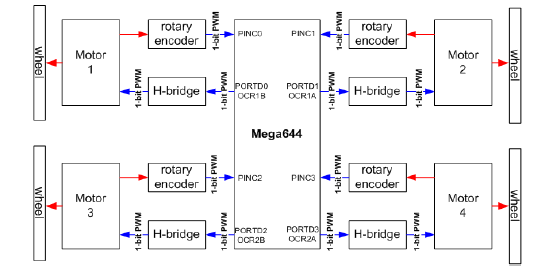





Published on Mar 01, 2025
A student has to develop a traction control system that detects wheel slip and adjusts the velocity of the wheels accordingly. Robotic vehicles are becoming increasingly complex and often need high levels of movement control. Specifically, when the wheels of a vehicle begin to slip, it is optimal to adjust their speed so that the vehicle moves towards its intended direction.
Applications include vehicles traveling over rough terrain, exploratory robots, and remote controlled cars. The purpose of this project is to design and implement a four wheel drive robot that monitors the rotational velocity of each wheel and limits the amount of slip when the vehicle is accelerating.
An electronic limited slip differential system controls the rotational velocity of the output shafts of a vehicle using speed sensors, anti-lock brakes, and microcontrollers. By electronically monitoring slipping, the microcontroller can activate the anti-lock brakes to slow down the wheel that is moving too quickly. An electronic system has the ability to be adjusted for different applications or conditions, such as on and off-road terrain, slippery weather, or driving at different speeds. This makes it much more attractive than a mechanical system.
While the dynamics of modern day traction control systems are very complex, the basic idea motivated this project. The applications for this design are very practical and universal. Any vehicle with two or more wheels will benefit from greater stability and movement control with this traction control system. The main component of this traction control system is a feedback loop that adjusts the velocity of each individual wheel to the velocity of the slowest wheel on the vehicle. It contains both positive and negative feedback by slowing down the fastest wheel motor and speeding up the slowest. This block diagram is implemented four times in software for each wheel.

The Mega644 microcontroller was used to generate four PWM signals to be sent to the H-Bridges and to read the rotary encoder signals. Electrical connections are shown in blue and mechanical connections are shown in red. Inputs to the microcontroller are labeled as PINxn and outputs are labeled as PORTxn. OCRnx are the PWM output registers that control the motor speed.
1. The Atmel Mega644 was used to control and monitor the acceleration and velocity of a vehicle. The major features of the Mega644 that were used for this project included one 8-bit timer, 4 PWM output pins, one Analog to Digital converter, and four standard I/O pins. The Mega644 chip has to built on a prototype board provided Prayog Labs. It features an easy way to power, attach a crystal clock, connect to a RS232 interface, and program the Atmel chip.
2. Motor Control Software
3. Encoder Hardware and Measurement Software
4. Hyperterm/ Debugging Code
5. Compiling Hardware Components Together
6. Robot Chassis Frame Extension
7. H-bridge Hardware
8. PC Board Fabrication
9. PWM Control Code
10.Debugging
11.Final Report